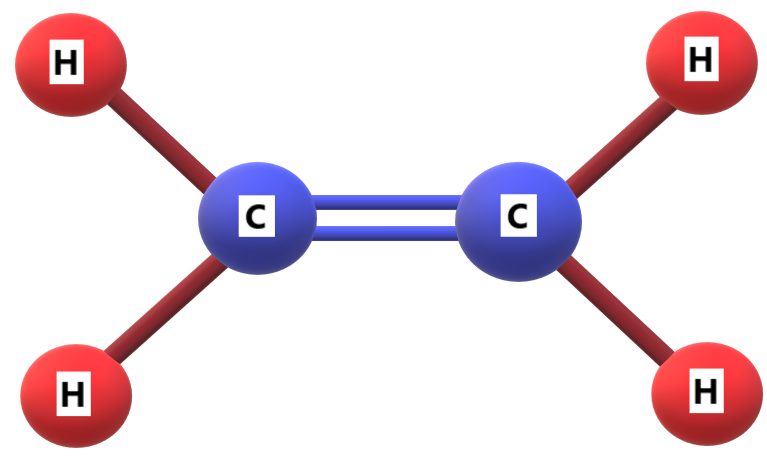
What is \[C\] Double Bond called?
Answer
221.1k+ views
Hint: Double bonds are created when two atoms trade two pairs of electrons. This type of relationship is stronger than a single bond but less stable since it is more reactive than a single bond. The double lines that make up the double bond sign stand in for a double bond between two atoms.
Complete Step by Step Solution:
When two substances are linked by a bond and at least four of the connected electrons—rather than just two—are shared, a double bond frequently results. Two carbon monoxide atoms, one hydrogen atom, and one hydrogen atom make up the most common compound with a doubly bonded ingredient.
Alkenes include the double carbon-carbon bonds and are unsaturated hydrocarbons with \[{C_n}{H_{2n}}\] as the molecular formula. This formula for molecules is quite similar to that of cycloalkanes. Alkenes are named using the same general naming conventions as alkanes, with the suffix changing to "ene."
Double bonds in hydrocarbons are demonstrated by changing the suffix "ane" to "ene". Where there are many double bonds, the suffix is changed to add a prefix that specifies how many double bonds are present. In the same way, the suffix "yne" is used to describe triple bonds.
An alkene that has a single alkyl group that is attached to the \[s{p^2}\] the hybridised carbon atom of the double bond is mono-substituted. A terminal alkene is an alkene that has its double bond at the end of the carbon atom chain. Alkenes that contain two, three, or four alkyl groups attached to the double bond's carbon atoms are referred to as di-, tri-, and tetra-substituted, respectively.
For example, Ethene \[({C_2}{H_4})\]is the simplest alkene which is often called by the common name ethylene.

Therefore, \[C\]double bond is called alkenes.
Note: As we know that the alkyl groups bonded to the \[s{p^2}\] hybridised carbon atoms of alkenes affect the stability of the double bond. The chemical reactivity of alkenes also is often affected by the number of alkyl groups that bonded to the \[s{p^2}\] hybridised carbon atoms. Then the alkenes by the number of alkyl groups attached to the \[C = C\] structural unit.
Complete Step by Step Solution:
When two substances are linked by a bond and at least four of the connected electrons—rather than just two—are shared, a double bond frequently results. Two carbon monoxide atoms, one hydrogen atom, and one hydrogen atom make up the most common compound with a doubly bonded ingredient.
Alkenes include the double carbon-carbon bonds and are unsaturated hydrocarbons with \[{C_n}{H_{2n}}\] as the molecular formula. This formula for molecules is quite similar to that of cycloalkanes. Alkenes are named using the same general naming conventions as alkanes, with the suffix changing to "ene."
Double bonds in hydrocarbons are demonstrated by changing the suffix "ane" to "ene". Where there are many double bonds, the suffix is changed to add a prefix that specifies how many double bonds are present. In the same way, the suffix "yne" is used to describe triple bonds.
An alkene that has a single alkyl group that is attached to the \[s{p^2}\] the hybridised carbon atom of the double bond is mono-substituted. A terminal alkene is an alkene that has its double bond at the end of the carbon atom chain. Alkenes that contain two, three, or four alkyl groups attached to the double bond's carbon atoms are referred to as di-, tri-, and tetra-substituted, respectively.
For example, Ethene \[({C_2}{H_4})\]is the simplest alkene which is often called by the common name ethylene.

Therefore, \[C\]double bond is called alkenes.
Note: As we know that the alkyl groups bonded to the \[s{p^2}\] hybridised carbon atoms of alkenes affect the stability of the double bond. The chemical reactivity of alkenes also is often affected by the number of alkyl groups that bonded to the \[s{p^2}\] hybridised carbon atoms. Then the alkenes by the number of alkyl groups attached to the \[C = C\] structural unit.
Recently Updated Pages
The hybridization and shape of NH2 ion are a sp2 and class 11 chemistry JEE_Main

What is the pH of 001 M solution of HCl a 1 b 10 c class 11 chemistry JEE_Main

Aromatization of nhexane gives A Benzene B Toluene class 11 chemistry JEE_Main

Show how you will synthesise i 1Phenylethanol from class 11 chemistry JEE_Main

The enolic form of acetone contains a 10sigma bonds class 11 chemistry JEE_Main

Which of the following Compounds does not exhibit tautomerism class 11 chemistry JEE_Main

Trending doubts
JEE Main 2026: Application Form Open, Exam Dates, Syllabus, Eligibility & Question Papers

Derivation of Equation of Trajectory Explained for Students

Hybridisation in Chemistry – Concept, Types & Applications

Understanding the Angle of Deviation in a Prism

How to Convert a Galvanometer into an Ammeter or Voltmeter

Degree of Dissociation: Meaning, Formula, Calculation & Uses

Other Pages
NCERT Solutions For Class 11 Chemistry Chapter 7 Redox Reaction

JEE Advanced Marks vs Ranks 2025: Understanding Category-wise Qualifying Marks and Previous Year Cut-offs

Hydrocarbons Class 11 Chemistry Chapter 9 CBSE Notes - 2025-26

Thermodynamics Class 11 Chemistry Chapter 5 CBSE Notes - 2025-26

NCERT Solutions ForClass 11 Chemistry Chapter Chapter 5 Thermodynamics

Equilibrium Class 11 Chemistry Chapter 6 CBSE Notes - 2025-26




